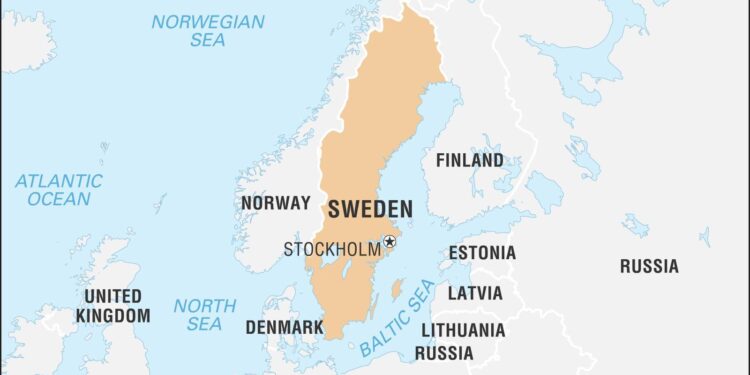Sweden is confronting increasing economic pressure as U.S. tariffs imposed under the Trump administration continue to impact its export-driven industries. Originally targeted at steel and aluminum, these tariffs have disrupted trade flows, raising concerns among Swedish manufacturers and policymakers about escalating tensions and the potential for further trade restrictions. As the ripple effects of Washington’s protectionist measures extend, Sweden faces mounting uncertainty over its future trade relationship with the United States.
Sweden Faces Economic Strain as Trump Tariffs Impact Key Industries
Sweden’s economy is increasingly burdened by the ripple effects of President Trump’s tariff policies, which have targeted a variety of exports crucial to the Scandinavian nation. Key sectors such as automotive manufacturing, steel production, and technology exports are now grappling with rising costs and disrupted supply chains. Industry leaders warn that without prompt action, the tariffs could lead to significant job losses and a slowdown in GDP growth. Companies are forced to reassess their global strategies as the added tariffs inflate production expenses and limit market access to the United States, one of Sweden’s most important trading partners.
Impact Highlights:
- Automotive exports: Faced with a 25% tariff, major car manufacturers are delaying new investments.
- Steel industry: Struggling with increased material costs and reduced competitiveness.
- Technology sector: Smaller tech firms experience revenue declines due to limited access to the U.S. market.
| Industry | Tariff Rate | Estimated Revenue Loss (2024) |
|---|---|---|
| Automotive | 25% | €1.2 billion |
| Steel | 25% | €800 million |
| Technology | 15% | €450 million |
Analyzing the Ripple Effects on Swedish Exporters and Consumer Markets
Swedish exporters are increasingly navigating a challenging landscape as tariffs introduced by the Trump administration disrupt global supply chains. Key industries such as automotive, machinery, and telecommunications have reported rising costs and contract renegotiations due to added import duties on steel and aluminum. The impact reaches beyond immediate tariffs, causing uncertainty that affects long-term investment plans and affects competitiveness in vital markets like the U.S. and China.
Consumers in Sweden also face indirect consequences stemming from this trade tension. With export firms absorbing higher costs, some price increases are inevitably passed on to the market. The ripple effects include:
- Higher retail prices for goods reliant on imported components
- Reduced product variety as companies streamline offerings to cut costs
- Slower economic growth due to weakening demand in export sectors
| Sector | Tariff Impact | Projected 2024 Effect |
|---|---|---|
| Automotive | +25% steel tariff | -4% export volume |
| Machinery | Increased component costs | -3% profit margin |
| Telecommunications | Raw material price surge | Supply delays |
Strategic Measures Recommended for Swedish Businesses to Mitigate Tariff Pressures
To navigate the intensifying tariff landscape, Swedish companies must adopt a multifaceted approach emphasizing agility and innovation. Diversifying supply chains away from U.S.-centric dependencies is paramount, reducing exposure to abrupt tariff escalations. Leveraging regional trade agreements like the EU’s existing free trade frameworks can buffer against costs, while simultaneously exploring alternative markets in Asia and Africa to maintain growth momentum.
Additionally, investment in advanced manufacturing technologies and digital transformation will enhance operational efficiency, helping offset tariff-induced price pressures. Financial hedging strategies, including currency and commodity risk management, can further stabilize revenue streams amid volatility. The table below outlines key strategic actions businesses should consider implementing:
| Strategic Measure | Primary Benefit | Example Initiative |
|---|---|---|
| Diversify Supply Chains | Reduced tariff exposure | Sourcing from Southeast Asia |
| Leverage Free Trade Agreements | Lower tariffs & quotas | Expand EU market penetration |
| Invest in Automation | Cost reduction & efficiency | Implement robotics in production |
| Financial Hedging | Mitigate currency risks | Use forward contracts |
- Policy Advocacy: Engage actively with government bodies to influence trade negotiations and protective measures.
- Product Innovation: Develop tariff-resilient goods that command premium pricing.
- Customer Diversification: Broaden client base geographically to dilute market-specific trade impacts.
The Way Forward
As tensions over trade policies persist, Sweden finds itself navigating an increasingly challenging economic landscape shaped by tariff pressures from the United States. With further measures on the horizon, industries and policymakers alike must brace for the evolving impacts on bilateral relations and the broader global market. The coming months will be critical in determining how Sweden adapts to this shifting trade environment and seeks new avenues for resilience amid mounting uncertainties.
















